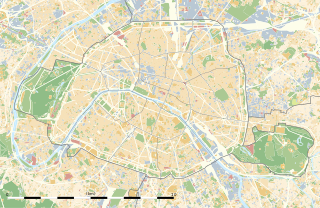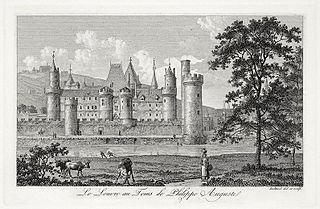 W
WThe Louvre Palace is a former royal palace located on the Right Bank of the Seine River in Paris, between the Tuileries Gardens and the church of Saint-Germain l'Auxerrois. Originally a fortress built in the medieval period, it became a royal palace in the 14th century under Charles V and was used from time to time by the kings of France as their main Paris residence. Its present structure has evolved in stages since the 16th century. In 1793, part of the Louvre became a public museum, now the Musée du Louvre, which has expanded to occupy most of the building.
 W
WThe Lescot Wing is the oldest portion above ground of the Louvre Palace, in Paris, France. It was executed to the designs of the architect Pierre Lescot between 1546 and 1551. Strongly tinged with Italian Mannerism, it became the Parisian Renaissance style, thus "setting the mold" for all later French architectural classicism.
 W
WThe Louvre, or the Louvre Museum, is the world's largest art museum and a historic monument in Paris, France. A central landmark of the city, it is located on the Right Bank of the Seine in the city's 1st arrondissement. Approximately 38,000 objects from prehistory to the 21st century are exhibited over an area of 72,735 square meters. In 2019, the Louvre received 9.6 million visitors, making it the most visited museum in the world.
 W
WThe Louvre Colonnade is the easternmost façade of the Palais du Louvre in Paris. It has been celebrated as the foremost masterpiece of French Architectural Classicism since its construction, mostly between 1667 and 1674. The design, dominated by two loggias with trabeated colonnades of coupled giant columns, was created by a committee of three, the Petit Conseil, consisting of Louis Le Vau, Charles Le Brun, and Claude Perrault. Louis Le Vau's brother, François Le Vau also contributed. Cast in a restrained classicizing baroque manner, it interprets rules laid down by the ancient Roman architect Vitruvius, whose works Perrault translated into French (1673).
 W
WThe Louvre Pyramid is a large glass and metal pyramid designed by Chinese-American architect I. M. Pei, surrounded by three smaller pyramids, in the main courtyard of the Louvre Palace in Paris. The large pyramid serves as the main entrance to the Louvre Museum. Completed in 1989, it has become a landmark of the city of Paris.
 W
WThe Louvre Castle was a castle built by King Philip II of France to reinforce the walls he had built around Paris and further protect the city. It was later demolished in stages to make way for the Louvre Palace. Its main location was on the right bank of the Seine river.
 W
WThe Pavillon de Flore, part of the Palais du Louvre in Paris, France, stands at the southwest end of the Louvre, near the Pont Royal. It was originally constructed in 1607–1610, during the reign of Henry IV, as the corner pavilion between the Tuileries Palace to the north and the Louvre's Grande Galerie to the east. The pavilion was entirely redesigned and rebuilt by Hector Lefuel in 1864–1868 in a highly decorated Napoleon III style. The most famous sculpture on the exterior of the Louvre, Jean-Baptiste Carpeaux's The Triumph of Flora, was added below the central pediment of the south facade at this time. The Tuileries Palace was burned by the Paris Commune in 1871, and a north facade, similar to the south facade, was added to the pavilion by Lefuel in 1874–1879. Currently, the Pavillon de Flore is part of the Musée du Louvre.
 W
WThe Pavillon de l’Horloge, also known as the Pavillon Sully, is a prominent pavilion located in the center of the west wing of the Cour Carrée of the Palais du Louvre in Paris. The two names Pavillon de l'Horloge and Pavillon Sully are now often reserved for the central pavilion's eastern and western faces, respectively.
 W
WThe Place du Louvre is a square immediately to the east of the Palais du Louvre in Paris, France. To the south is the Quai du Louvre and beyond that is the River Seine. The Hôtel du Louvre is also located here, between the Louvre Palace and the Palais Royal.
 W
WThe Port du Louvre is a walkway running along the River Seine immediately to the south of the Louvre in Paris, France. It is parallel to and lower than the larger Voie Georges Pompidou road between it and the Louvre.
 W
WThe Louvre Pyramide inversée is a skylight constructed in the Carrousel du Louvre, an underground shopping mall in front of the Louvre Museum in France. It may be thought of as a smaller sibling of the more famous Louvre Pyramid proper, yet turned upside down: its upturned base is easily seen from outside.
 W
WThe Quai François Mitterrand is a quay by the River Seine in Paris, France, along the stretch where the Palais du Louvre is situated. Formerly Quai du Louvre, it was renamed Quai François Mitterrand after the former French president on October 26, 2003.